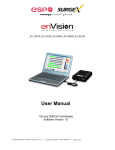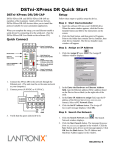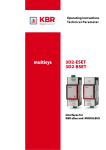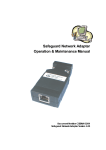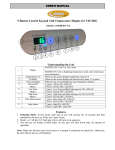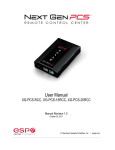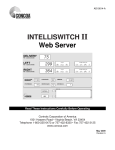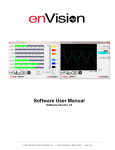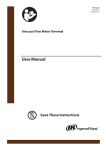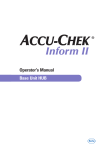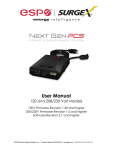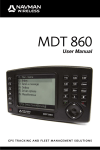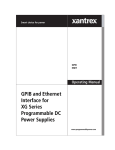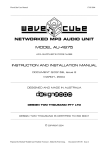Download User Manual
Transcript
RP-IP RP-IP-GNS User Manual © 2015 Electronic Systems Protection, Inc. / Technical Support: 1-800-645-9721 / espei.com / UM-Remote-Portal-Rev-B User Manual © 2015 Electronic Systems Protection, Inc. / Technical Support: 1-800-645-9721 / espei.com Page 1 User Manual I. HARDWARE 3 1. RP-IP ............................................................................................................................. 3 2. RP-IP-GNS .................................................................................................................... 3 II. SETUP AND CONFIGURATION 4 1. IP SETTINGS AND CONFIGURATION ....................................................................................4 2. LAN OPERATION AND CONFIGURATION ..............................................................................4 3. WAN CONFIGURATION .....................................................................................................8 III. OPERATION 1. 2. 3. 4. 9 JAVA APPLET .................................................................................................................. 9 MOBILE ..........................................................................................................................10 SNMP …………………….……………………………………………………………………..10 COM PORT REDIRECTION .......…………………….…………………………………………..10 IV. ADVANCED CONFIGURATION 11 V. FIRMWARE UPGRADE 13 VI. SPECIFICATIONS 14 © 2015 Electronic Systems Protection, Inc. / Technical Support: 1-800-645-9721 / espei.com Page 2 User Manual I. HARDWARE: 1. RP-IP a. LAN: Connect to local network using Cat5e patch cable b. XG / EV Data Port: Connect to XG or EV product using 6p6c RJ25 patch cable with Standard pin out c. Power: Input power connection. USB Mini B, 5VDC, 500mA minimum d. LEDs: LED State Meaning EV, XG Toggle EV solid, XG off XG solid, EV off e. Buttons: Button Reset Mode 2. Establishing network connectivity enVision operating mode Next Gen operating mode Action Press and hold for 5 seconds, then release to reset the unit to factory defaults. Will reset IP settings to factory default. Press and hold for 5 seconds, then release to toggle between EV and XG operating modes RP-IP-GNS a. LAN: Connect to local network using Cat5e patch cable b. XG / EV Data Port: Connect to XG or EV product using 6p6c RJ25 patch cable with Standard pin out c. Power: Input power connection. Barrel, 12VDC, 1A minimum d. LEDs: LED State EV, XG Toggle EV solid, XG off XG solid, EV off Switch Status Power e. Buttons: Button Reset Mode Meaning Establishing network connectivity enVision operating mode Next Gen operating mode Link/Activity LEDs for each switch port RP-IP-GNS Power Indicator Action Press and hold for 5 seconds, then release to reset the unit to factory defaults. Will reset IP settings to factory default. Press and hold for 5 seconds, then release to toggle between EV and XG operating modes © 2015 Electronic Systems Protection, Inc. / Technical Support: 1-800-645-9721 / espei.com Page 3 User Manual II. SETUP AND CONFIGURATION: 1. IP Settings and Configuration a. Factory Default: Acquires IP address automatically via DHCP b. Determine assigned IP address by one of the following methods: 2. i Access router table ii Download and run ESP RP-IP Discover Utility available on the Downloads tab here: http://www.espei.com/products/remote-portal iii Download and install Lantronix DeviceInstaller: http://www.lantronix.com/device-networking/utilities-tools/device-installer.html LAN Operation and Configuration a. Using a web browser with JavaScript enabled, navigate to http://IPAddress/config where the IPAddress is the IP Address of the RP-IP. i When prompted for a User Name and Password, leave both fields blank and press Log In. ii Important: For any changes to be applied, press the OK button at the bottom of the section, then press Apply Settings in the left hand menu, and finally wait for the RP-IP to reboot with new settings in place. iii Home Page: View firmware and configuration information currently in use. © 2015 Electronic Systems Protection, Inc. / Technical Support: 1-800-645-9721 / espei.com Page 4 User Manual b. Network Settings: View and change IP Configuration. i. Select Obtain IP address automatically to automatically receive an IP address 1) BOOTP: Select Enable to permit the Bootstrap Protocol (BOOTP) server to assign the IP address from a pool of addresses automatically. Enable is the default. 2) DHCP: Select Enable to permit the Dynamic Host Configuration Protocol (DHCP) to assign a leased IP address to the RP-IP automatically. Enable is the default. 3) AutoIP: Select Enable to permit the RP-IP to generate an IP in the 169.254.x.x address range with a Class B subnet. Enable is the default. 4) DHCP Host Name: Enter the desired host name for the RP-IP. © 2015 Electronic Systems Protection, Inc. / Technical Support: 1-800-645-9721 / espei.com Page 5 User Manual ii. Select Use the following IP configuration to manually specify the IP address. 1) IP Address: If DHCP is not used to assign IP addresses, enter it manually in decimal-dot notation. The IP address must be set to a unique value in the network. 2) Subnet Mask: A subnet mask defines the number of bits taken from the IP address that are assigned for the host part. 3) Default Gateway: The gateway address, or router, allows communication to other LAN segments. The gateway address should be the IP address of the router connected to the same LAN segment as the unit. The gateway address must be within the local network. 4) DNS Server: The DNS server allows the name of a remote machine to be resolved automatically. Enter the IP address of the DNS server. If the device is DHCP enabled, the DHCP server provides the DNS server IP address, which will override this configured value. Note: This setting is applicable only in Manual Connection mode. iii. SNMP 1) Select Enable or Disable to enable or disable the SNMP protocol. 2) SNMP Manager: Specify the IP address of the SNMP manager. 3) The SNMP MIB may be downloaded on the Downloads tab on this page: http://www.espei.com/products/remote-portal iv. Ethernet Configuration 1) Auto Negotiate: With this option, the Ethernet port auto-negotiates the speed and duplex with the hardware endpoint to which it is connected. This is the default. 2) Speed: The speed of data transmission. The default is 100 Mbps. This option is only available when Auto Negotiate is not enabled. 3) Duplex: The direction of data transmission. The default is Full. This option is only available when Auto Negotiate is not enabled. © 2015 Electronic Systems Protection, Inc. / Technical Support: 1-800-645-9721 / espei.com Page 6 User Manual c. Server: View and change the embedded Server settings. i. PCS Communication 1) Mode: Select enVision (EV) or NextGen (XG) operational mode. 2) TCP Server Port: Specify the port for serial data. ii. Server Configuration 1) 2) Enhanced Password: Selecting this option enables advanced password creation, allowing you to create passwords up to 16 bytes in length. Disabling this option disables advanced password creation, allowing you to create basic passwords up to 4 bytes in length. Telnet/Web Manager Password: Enter the password required for Telnet configuration and Web Manager access. © 2015 Electronic Systems Protection, Inc. / Technical Support: 1-800-645-9721 / espei.com Page 7 User Manual iii. Advanced 1) ARP Cache Timeout: When the unit communicates with another device on the network, it adds an entry into its ARP table. ARP Cache timeout defines the number of seconds (1-600) before it refreshes this table. 2) TCP Keepalive: TCP Keepalive time defines how many seconds the unit waits during an inactive connection before checking its status. If the unit does not receive a response, it drops that connection. Enter a value between 0 and 60 seconds. 0 disables keepalive. The default setting is 45. 3) Monitor Mode @ Bootup: Select Disable to disable entry into the monitor mode using the 'yyy' or 'xx1' key sequence at startup. This field prevents the unit from entering monitor mode by interpreting the stream of characters that are received during the device server's initialization at startup. 4) CPU Performance Mode: Do not adjust. Default is Regular. 5) HTTP Server Port: This option allows the configuration of the web server port number. The valid range is 1-65535. The default port is 80. 6) Config Server Port: Not applicable. 7) MTU Size: The Maximum Transmission Unit (MTU) is the largest physical packet size a network can transmit for TCP and UDP. Enter between 512 and 1400 bytes. The default is 1400 bytes. 8) TCP Re-transmission timeout: The desired TCP re-transmission timeout value. If the ACK is not received for a packet sent from the RP-IP device, then the unit will retransmit the data. The valid range is 500-4000 msec. The default is 500 msec. 3. d. Apply Settings: Applies the currently specified settings. e. Apply Defaults: Reset the unit to factory defaults. Will not modify IP settings. WAN Configuration a. To access the RP-IP Java applet from outside of the local network, the following 2 ports must be forwarded through the firewall to the internal IP address of the RP-IP: i. HTTP Server Port (Default 80) ii. TCP Server Port (Default 10001) b. To access the RP-IP mobile page from outside of the local network, the following port must be forwarded through the firewall to the internal IP address of the RP-IP: i. HTTP Server Port (Default 80) © 2015 Electronic Systems Protection, Inc. / Technical Support: 1-800-645-9721 / espei.com Page 8 User Manual III. OPERATION: 1. Java Applet a. Download and install the current JRE from: www.java.com Java applet operation requires a computer with an operating system which supports the installation of a Java Runtime Environment (JRE), including MS Windows, Apple OSX, and various Linux distributions. b. Using a web browser, navigate to the IP address of the RP-IP. Include the HTTP Server Port if set to a value other than 80 in this format: http://IP:PORT enVision PCS Mode enVision PCS Mode Next Gen PCS Mode Next Gen PCS Mode c. Refer to the enVision Software User Manual for information regarding software operation: http://espei.com/products/envision/ © 2015 Electronic Systems Protection, Inc. / Technical Support: 1-800-645-9721 / espei.com Page 9 User Manual 2. Mobile a. When using a browser which does not support Java, a link to the mobile page will be provided. The mobile page requires that JavaScript be enabled. enVision PCS Mode 3. Next Gen PCS Mode SNMP a. The RP-IP and RP-IP-GNS provide monitoring and control via SNMP. The SNMP MIB may be downloaded here: http://www.espei.com/products/remote-portal 4. COM Port Redirection a. The RP-IP and RP-IP-GNS may also be used with COM Port Redirection software and the standard Next Gen PCS and enVision PCS desktop software applications. © 2015 Electronic Systems Protection, Inc. / Technical Support: 1-800-645-9721 / espei.com Page 10 User Manual IV. ADVANCED CONFIGURATION: 1. Advanced settings may be adjusted via Telnet on port 9999. a. Upon establishing a connection, the following information is displayed: *** ESP PCS *** MAC address 0080A39C878F Software version V6.9.0.3 (140902) CPK6903_XPT05 Press Enter for Setup Mode b. To enter Setup Mode, press Enter within 5 seconds. The configuration settings display, followed by the Change Setup menu: enVision (EV) Mode *** basic parameters Hardware: Ethernet TPI IP addr - 0.0.0.0/DHCP/BOOTP/AutoIP, no gateway SNMP Manager not set DHCP device name : not set *** Security SNMP is enabled SNMP Community Name: public Telnet Setup is enabled TFTP Download is enabled Port 77FEh is enabled Web Server is enabled Web Setup is enabled ECHO is disabled Enhanced Password is disabled ***************** Channel 1 ***************** Connect Mode : C0 Source Port : 10001 Destination Port : 00000 Destination IP : 0.0.0.0 CPU performance : Standard Change Setup: 0 Server configuration 1 Channel 1 configuration 5 Debug 6 Security 7 factory defaults 8 exit without save 9 save and exit Your choice ? c. Select an option on the menu by entering the number of the option in the Your choice ? field and pressing Enter. d. To enter a value for a parameter, type the value and press Enter, or to confirm a current value, just press Enter. e. Important: When you are finished, save the new configuration (option 9). The unit reboots. © 2015 Electronic Systems Protection, Inc. / Technical Support: 1-800-645-9721 / espei.com Page 11 User Manual f. Server configuration: Allows for the configuration of the following parameters: • IP Address • Gateway IP Address • Netmask • SNMP Manager IP Address • Telnet configuration password • DHCP device name • DHCP FQDN option g. Channel 1 configuration: Allows for the configuration of the following parameters: • Connect Mode (Do not modify. Default is C0.) • Source Port • Destination Port (Currently Unused) • Destination IP (Currently Unused) • Enable Pack Control (Do not modify. Default is No.) • Disconnect Time h. Debug: Not intended for general use. Enables EV/XG data communication debug. i. Security: Allows for the configuration of the following parameters: • Disable SNMP • SNMP Community Name • Disable Telnet Setup • Disable TFTP Firmware Update • Disable Port 77FEh (configuration port) • Disable Web Server • Disable Web Setup • Disable ECHO ports • Enable Enhanced Password • Use Encryption (Currently Unused) j. Factory defaults: Reset the unit to factory defaults. Will not modify IP settings. k. Exit without save: Exits and terminates telnet session without modifying parameters. l. Save and exit: Stores parameters and reboots with new parameters in place. © 2015 Electronic Systems Protection, Inc. / Technical Support: 1-800-645-9721 / espei.com Page 12 User Manual V. FIRMWARE UPGRADE: 1. Download and install the Lantronix Device Installer: http://www.lantronix.com/devicenetworking/utilities-tools/device-installer.html 2. Download the Remote Portal firmware file (*.lxi format): http://espei.com/products/remote-portal/ 3. Start the Lantronix Device Installer. The RP should be automatically detected, and listed on the right side with a name of “XPort-05” 4. Select the unit by clicking on its name, and then press the “Upgrade” button now available on the top menu bar 5. A Device Upgrade Wizard window will open Select “Use a specific installation file…” and then click the “Browse” button 6. Navigate to the firmware file (*.lxi), select it, and press the “Open” button © 2015 Electronic Systems Protection, Inc. / Technical Support: 1-800-645-9721 / espei.com Page 13 User Manual VI. 7. Click the “Next” button on the wizard to begin the upgrade process 8. Close the Device Upgrade Wizard when the upload process is complete, and then close the Device Installer Utility SPECIFICATIONS: Parameter Power Requirement Specification RP-IP RP-IP-GNS Network Interface Protocols Supported LEDs Dimensions Weight Temperature Range Humidity Range Agency Listings RP-IP RP-IP-GNS RP-IP RP-IP-GNS RP-IP RP-IP-GNS 5VDC, 2W 12VDC, 2W RJ45 Ethernet 10BASE-T or 100BASE-TX (auto-sensing) ARP, TCP/IP, Telnet, SNMP, DHCP, BOOTP, TFTP, Auto IP, and HTTP 10BASE-T & 100BASE-TX Link Activity, Full/half duplex. EV/XG mode indicators. 3.38” W x 2.2” D x 0.9” H 6.5” W x 2.75” D x 1” H 0.2 lbs. 0.5 lbs. 5C to 40C 5% to 95% R.H. Non-condensing ETL Certified to UL 60950-1 (In Progress) © 2015 Electronic Systems Protection, Inc. / Technical Support: 1-800-645-9721 / espei.com Page 14
















